Talks with Jan
 |
 |
 |
 |
 |
 |
 |
Heading Toward a ‘Church Beyond Walls’
My friend Jan asked me, “What is the synodal way?” “These new words are confusing,” she complained. “I know the synodal way means going to the people to ask what they want. But how is this going to be put into practice in the structure of the Church?” I thought the best way to explain it is to point to an example.
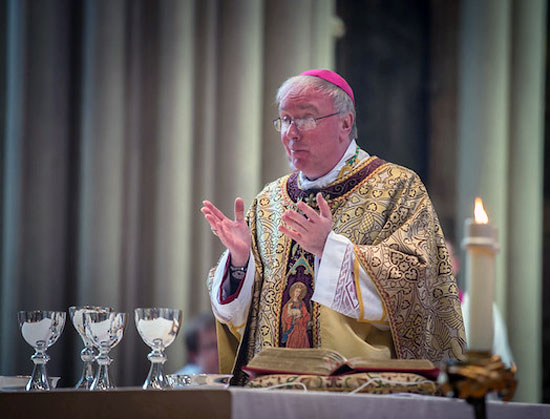 And so I invited Jan to look at the sheepish and sardonic face of the English Bishop of Portmouth Philip Egan celebrating Mass with his glass chalices. He has every reason to be so smug since he is presenting a diocesan model of how to follow the
synodal way. This will make him even more pleasing to Francis than he already is.
And so I invited Jan to look at the sheepish and sardonic face of the English Bishop of Portmouth Philip Egan celebrating Mass with his glass chalices. He has every reason to be so smug since he is presenting a diocesan model of how to follow the
synodal way. This will make him even more pleasing to Francis than he already is.
In a recent pastoral letter the Bishop, who has been called “a powerhouse of the new evangelization of JPII,” announced “with great joy and confidence” the plan to reduce the Diocese’s 87 parishes to 24 over the next five years. It is, ironically, a “part of a 10 year mission plan for evangelization.”
It is certainly a strange “evangelization.” Only in the Vatican II Church does a plan for evangelization consist in CLOSING churches instead of opening new ones.
Bishop Egan complacently announces some of the reasons for the “crucial structural changes”: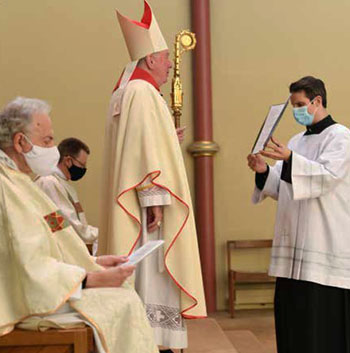 These and other factors are the pretexts he uses to reduce parishes from 87 to 24 “pastoral centers,” each containing between 2-13 parishes that will become single “pastoral centers” by 2028. Each parish must submit a local plan to implement the structural change to Bishop Egan by September of 2023.
These and other factors are the pretexts he uses to reduce parishes from 87 to 24 “pastoral centers,” each containing between 2-13 parishes that will become single “pastoral centers” by 2028. Each parish must submit a local plan to implement the structural change to Bishop Egan by September of 2023.
The Bishop of Portmouth seems oblivious to the fact that these devastating changes are not the good, but rather the disastrous consequences of Vatican II. To the contrary, he credits the Council with responding to secularization by “going back to the basics to modernize every dimension of Christian life” in order to evangelize the modern world. (p. 7)
Egan paints a very rosy picture of moving toward a new type of Church. To achieve this great structural shift, he calls for a “deep, spiritual change” in everyone. It is something “crucial,” because it is shifting the Church to a more “synodal way of working.” (p. 8)
A mission plan to destroy the visible Church
This drastic reduction of parishes was part of the recently released diocesan Mission Plan – You Will Be My Witness. Its cover is quite symbolic.
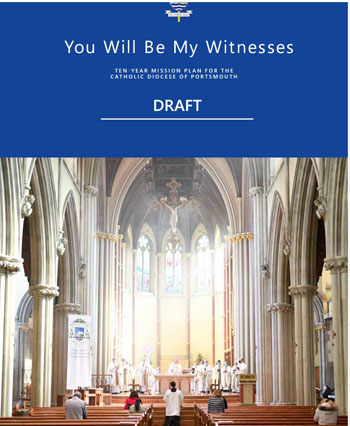 It presents a gothic English Church with a simple table in the sanctuary. Gone are the artistic altars, tabernacle, statues, candles or any form of rich decor or adornment; even the stained glass windows are faded and barely visible. The only Catholic symbol is a crucifix hovering from the high ceiling.
It presents a gothic English Church with a simple table in the sanctuary. Gone are the artistic altars, tabernacle, statues, candles or any form of rich decor or adornment; even the stained glass windows are faded and barely visible. The only Catholic symbol is a crucifix hovering from the high ceiling.
The figures of the faceless clergy are also fading away under the strong light streaming onto the sanctuary, as if their material presence were gradually being replaced by a nonphysical spiritual light from outside.
The pews in the large building are almost empty, just a few persons in prayer here or there. The message is that there is no need for this large building with all of its expenses for these few people. The old structure no longer works...
But, we should not be sad, for the old structure is being replaced by a light from outside that will eliminate the need for those complicated liturgical ceremonies involving those large numbers of clergy. It is the “Holy Spirit” that is “creatively responding” to the challenges we face. (p. 8)
We have here the immolation of the Catholic Church by her own authorities, a light-filled destruction worked by the “Spirit” to create a new “pneumatic” Church composed preponderantly of spiritual gifts, and no longer of doctrines and laws.
'A church beyond walls'
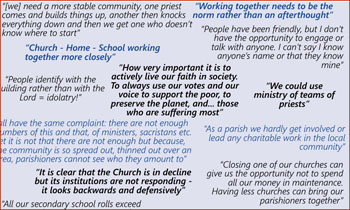
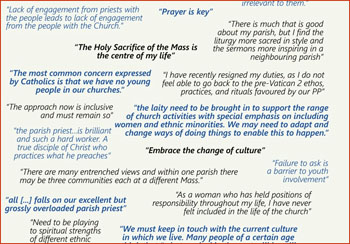
The aim, we are told in the Mission Plan is to become “a church beyond walls,” a people “going out into the margins and sharing the love and mercy of God with the wider world in practical ways.”
With input from both clergy and lay faithful, the “church beyond walls” will “develop its voice as advocates for social justice” working with Caritas. Instead of studying Catechism, dry doctrine and worn out rules, the youth will establish a Youth Social Action Enterprise under the Caritas umbrella in order to “engage in outreach.”
The Bishop justifies his new plan as his response to listening to the voices of the people through the synodal process. The replies of over 5,000 people to the Synod questions resulted in new priorities to meet the needs of modern times.
Missionary community, not parish
The missionary community is supposed to be “more than simple parishes.” The structures supporting it will not be “a drain on limited resources,” but rather will reflect the needs of the Church today. Visible structures like large cathedrals and grandiose churches are no longer important. All that is needed is a “sustainable” building that is “fit for the purpose” and “welcoming.”
Like Protestants, its members should “first and foremost foster a personal relationship with Jesus Christ.” The missionary community also should abandon all ideas of conversion. The new evangelization must be inclusive and tolerant, welcoming everyone: LGBTs, strangers, seekers et al.
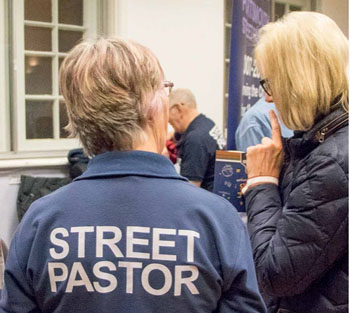 Throughout the draft plan, the Bishop refers to Francis’ Evangelii gaudium as he exhorts missionary members to be open to dialogue, to work with other “religions,” and always to strive to foster mutual understanding and respect. (p. 44)
Throughout the draft plan, the Bishop refers to Francis’ Evangelii gaudium as he exhorts missionary members to be open to dialogue, to work with other “religions,” and always to strive to foster mutual understanding and respect. (p. 44)
Bishop Egan does not forget to include the ecological concerns of Francis expressed in Laudato sí, which he also quotes. The crisis of social injustice and environmental injustice are closely related, he states, and both must be addressed following the “synodal way.”
Instead of examining their consciences to make good confessions, community members must expand their horizons and analyze their carbon footprint, consider environmental concerns in all their decision making, become more energy efficient and reduce the environmental impact in their lifestyles. (p. 49)
The renewal of structures following the synodal way fulfills the dream of Francis that he expresses in Evangelii gaudium: “I dream of a ‘missionary option,’ that is, a missionary impulse capable of transforming everything, so that the Church’s customs, ways of doing things, times and schedules, language and structures can be suitably channeled for the evangelization of today’s world rather than for her self-preservation.“ (p. 27)
I suggest, dear Jan, that you page through the Mission Plan of Bishop Egan. You will find, I believe, a first sketch of the Church of the Future following the synodal way.
If things continue along the synodal way, we will be seeing the same plan being drawn up here in the U.S. More beautiful churches will close and be condensed, always with the aim of achieving a “more spiritual” and less visible Church that follows the synodal way. Always with the movement from monarchical to democratic, from hierarchical to egalitarian, from sacral to proletarian. (p. 39)
I say “if” because we should pray fervently that Our Lady will intervene in History, as she promised, before this process completely changes the face of Holy Mother Church.

Bishop Egan celebrating Mass with glass chalices
In a recent pastoral letter the Bishop, who has been called “a powerhouse of the new evangelization of JPII,” announced “with great joy and confidence” the plan to reduce the Diocese’s 87 parishes to 24 over the next five years. It is, ironically, a “part of a 10 year mission plan for evangelization.”
It is certainly a strange “evangelization.” Only in the Vatican II Church does a plan for evangelization consist in CLOSING churches instead of opening new ones.
Bishop Egan complacently announces some of the reasons for the “crucial structural changes”:
- The numbers of church-goers has declined so greatly that they cannot maintain the churches;
- The parishioners’ average weekly donations are 2.35 pounds – “less than a cappuccino”;
- The numbers are falling: In the last decade, baptism are 35% down, marriages 32% down, Mass attendance 44% down, confirmations 40% down, priestly vocations (estimated 66% down in the next two decades). (You Will Be My Witness – Mission Plan, p. 7)

The Bishop closed all his churches in the Covid panic
The Bishop of Portmouth seems oblivious to the fact that these devastating changes are not the good, but rather the disastrous consequences of Vatican II. To the contrary, he credits the Council with responding to secularization by “going back to the basics to modernize every dimension of Christian life” in order to evangelize the modern world. (p. 7)
Egan paints a very rosy picture of moving toward a new type of Church. To achieve this great structural shift, he calls for a “deep, spiritual change” in everyone. It is something “crucial,” because it is shifting the Church to a more “synodal way of working.” (p. 8)
A mission plan to destroy the visible Church
This drastic reduction of parishes was part of the recently released diocesan Mission Plan – You Will Be My Witness. Its cover is quite symbolic.

A church to be replaced by a ‘sustainable building’
The figures of the faceless clergy are also fading away under the strong light streaming onto the sanctuary, as if their material presence were gradually being replaced by a nonphysical spiritual light from outside.
The pews in the large building are almost empty, just a few persons in prayer here or there. The message is that there is no need for this large building with all of its expenses for these few people. The old structure no longer works...
But, we should not be sad, for the old structure is being replaced by a light from outside that will eliminate the need for those complicated liturgical ceremonies involving those large numbers of clergy. It is the “Holy Spirit” that is “creatively responding” to the challenges we face. (p. 8)
We have here the immolation of the Catholic Church by her own authorities, a light-filled destruction worked by the “Spirit” to create a new “pneumatic” Church composed preponderantly of spiritual gifts, and no longer of doctrines and laws.
'A church beyond walls'

The draft plan presents the people’s opinions gathered in the synodal process to justify the structural changes

The aim, we are told in the Mission Plan is to become “a church beyond walls,” a people “going out into the margins and sharing the love and mercy of God with the wider world in practical ways.”
With input from both clergy and lay faithful, the “church beyond walls” will “develop its voice as advocates for social justice” working with Caritas. Instead of studying Catechism, dry doctrine and worn out rules, the youth will establish a Youth Social Action Enterprise under the Caritas umbrella in order to “engage in outreach.”
The Bishop justifies his new plan as his response to listening to the voices of the people through the synodal process. The replies of over 5,000 people to the Synod questions resulted in new priorities to meet the needs of modern times.
Missionary community, not parish
The missionary community is supposed to be “more than simple parishes.” The structures supporting it will not be “a drain on limited resources,” but rather will reflect the needs of the Church today. Visible structures like large cathedrals and grandiose churches are no longer important. All that is needed is a “sustainable” building that is “fit for the purpose” and “welcoming.”
Like Protestants, its members should “first and foremost foster a personal relationship with Jesus Christ.” The missionary community also should abandon all ideas of conversion. The new evangelization must be inclusive and tolerant, welcoming everyone: LGBTs, strangers, seekers et al.

A missionary community that goes to the streets, not the church building
Bishop Egan does not forget to include the ecological concerns of Francis expressed in Laudato sí, which he also quotes. The crisis of social injustice and environmental injustice are closely related, he states, and both must be addressed following the “synodal way.”
Instead of examining their consciences to make good confessions, community members must expand their horizons and analyze their carbon footprint, consider environmental concerns in all their decision making, become more energy efficient and reduce the environmental impact in their lifestyles. (p. 49)
The renewal of structures following the synodal way fulfills the dream of Francis that he expresses in Evangelii gaudium: “I dream of a ‘missionary option,’ that is, a missionary impulse capable of transforming everything, so that the Church’s customs, ways of doing things, times and schedules, language and structures can be suitably channeled for the evangelization of today’s world rather than for her self-preservation.“ (p. 27)
I suggest, dear Jan, that you page through the Mission Plan of Bishop Egan. You will find, I believe, a first sketch of the Church of the Future following the synodal way.
If things continue along the synodal way, we will be seeing the same plan being drawn up here in the U.S. More beautiful churches will close and be condensed, always with the aim of achieving a “more spiritual” and less visible Church that follows the synodal way. Always with the movement from monarchical to democratic, from hierarchical to egalitarian, from sacral to proletarian. (p. 39)
I say “if” because we should pray fervently that Our Lady will intervene in History, as she promised, before this process completely changes the face of Holy Mother Church.
Posted November 28, 2022
______________________
 Volume I |
 Volume II |
 Volume III |
 Volume IV |
 Volume V |
 Volume VI |
 Volume VII |
 Volume VIII |
 Volume IX |
 Volume X |
 Volume XI |
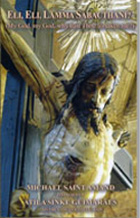 Special Edition |
